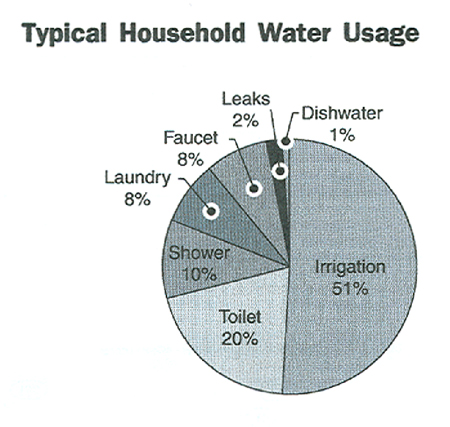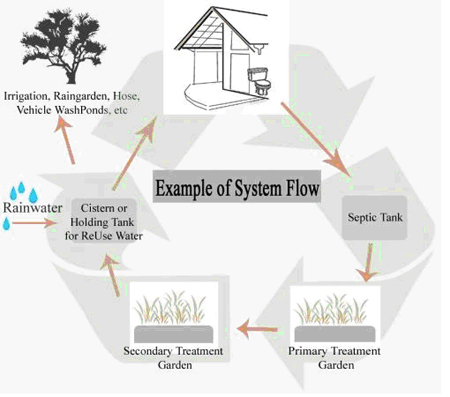 you'll
see that in an average household, most water is being used for irrigation, usually
of the lawn. Besides taking the usual and obvious steps (such as fixing leaks;
using a low-flow showerhead; doing only full loads of laundry; and, while shaving,
washing dishes, etc., closing/plugging the sink basins) to reduce our water
consumption, there are other steps to consider:
you'll
see that in an average household, most water is being used for irrigation, usually
of the lawn. Besides taking the usual and obvious steps (such as fixing leaks;
using a low-flow showerhead; doing only full loads of laundry; and, while shaving,
washing dishes, etc., closing/plugging the sink basins) to reduce our water
consumption, there are other steps to consider: -Xeriscaping: A good landscaping design and maintenance practice can reduce water needs.
-Ecosystems for wastewater treatment
-A Living Machine
-Rainwater Harvesting/Catchment, Grey Water use.
Xeriscaping Water-Wise Landscaping
Xeriscaping deals mostly with slope, plants, plant groups, watering methods, and soil. Shape and other aspects of design can be dealt with by traditional principles of landscape design. It is Water Efficient Landscaping, which can reduce water use by 50 percent without compromising the aesthetic qualities of the landscape.
Xeriscaping generally requires less water, fertilizer, maintenance, and pest control than traditional landscaping.
The main fundamentals of xeriscape are:
-PLANNING AND DESIGN
-CREATE PRACTICAL TURF AREAS - manageable sizes, shapes, and the right grasses.
-SELECT LOW WATER REQUIRING PLANTS - select native or adaptive plants and group plants of similar water needs together.
-USE SOIL AMENDMENTS - like compost, manure, leaf mold, etc.
-USE MULCHES - to reduce evaporation & to keep the soil cool.
-IRRIGATE EFFICIENTLY - with properly designed sprinkler systems.
-MAINTAIN THE LANDSCAPE PROPERLY
There are two approaches to xeriscape.
-One is to "adjust" your existing landscape to be more water-wise.
-The other is to design and construct an entirely new water-wise landscape.
The basics of transforming an existing landscape are really very simple. We'll look at xeriscaping basics and principles here, and for design considerations you can go to Xeriscape Design Ideas or the principles of landscape design.
Since Xeriscaping is not just for rocks and cactuses anymore, but includes many colorful drought-tolerant plants native to other climates such as Southern Europe, North Africa, Western Asia, South Africa, and Australia, a reasonable knowledge of plants is an essential key to a successful water-wise garden or any landscape design.
You can discover a lot of helpful information about native plants and their properties from: xeriscaping and native plant directory. However, if you're serious about creating your water-wise landscape, you should have a good plant encyclopedia in your gardening library. If you don't already own one, click here to find out which plant encyclopedia is best for you.
Proper grouping of plants is an important part of xeriscaping. Grouping plants with similar water needs allows them to be watered as required with very little waste. By planting high water-use plants separately from low water-use plants, your irrigation system can be zoned according to plant needs.
Watering: Infrequent deep waterings is better than frequent shallow waterings. The same is especially true for xeriscape plants. Most non-xeric plants require a deep soak about once a week in dry summer. Xeric (drought-tolerant) plants require a soak about every two to three weeks once established.
Proper grading allows water to soak into the soil and be used by plants. Slopes can be terraced or simple wells around each plant can be created.
To see an example of how we used terracing in a water-wise landscape, go to terraced xeriscape
From: http://www.the-landscape-design-site.com/xeriscaping.html
Ecosystem for Wastewater Treatment
How a Typical Designed Ecosystem for Wastewater Treatment Works:

- Nutrient rich water from toilets, showers and sinks is collected in an underground septic tank.
-The solids settle and the uppermost water is pumped into the primary treatment cell
-Treatment cells may be constructed wetlands, vegetated soil filters or a combination system.
-Water flows through the cells, soils and plant roots.
-Filtered water is stored in a cistern underground where collected rainwater can added.
-Chlorine is added to the cleansed water.
-Clean water is released as needed for reuse to flush toilets, irrigate a landscape or for aesthetic landscape features.
For more information on Water Recycling. Integrated Water Strategies | 1434 Farrington Rd, Suite 600, Apex, NC 27502 Phone: (919) 367-8565 | Contact Us
Living Machine
A Living Machine is an advanced biofilter that has been designed to treat blackwater sewage in wetland environments. It does the job of eliminating the human threat to our lakes, streams and oceans, through the purification of our raw sewage.
Microorganisms are the basis for the Living Machine. The process goes: anaerobic septic tank, anoxic reactor, closed aerobic tank (with plants to filter gases), open aerobic tank(s) (with snailS-, shrimp and fish), sludge is redirected back to the septic tank (or composted), while water goes to a wetland (usually indoor); finally it is ready for returning to the environment. If further treated properly (without chemicals) studies show that the water could even be consumed more safely than when first polluted.
Biomechanical, a Living Machine is part nature part machine. Living Machines are very practical and very real. The uses of this Living Machine effluent range from the large scale crop irrigation to the small scale bathroom shower.
Whitewater is clean and drinkable, greywater is not drinkable, but not highly polluted either, while blackwater has come in contact with human fecal material and is unfit for return to the environment without proper treatment (as it is an extremely dangerous pollutant).
Living Machines are dependable and insure a safe discharge of previously contaminated blackwaters into useful and efficient grey and white water. Living Machines provide communities, industries, academic institutions and government agencies with cost-effective, environmentally sound systems to meet their wastewater treatment needs. The systems are frequently integrated into water reuse systems which minimize energy use. Living Machine Systems have successfully treated wastewater for industrial facilities, resorts, communities and institutions throughout the world.